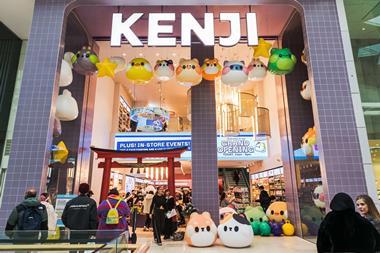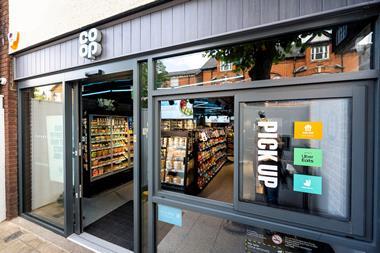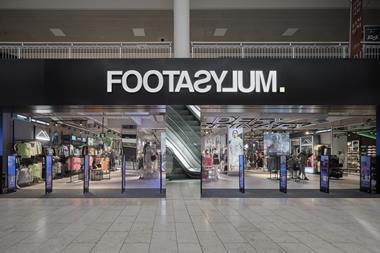Nine years after launching the Nike Town store at Oxford Circus, US sportswear brand Nike is a little more than halfway through giving its flagship store a makeover. At most shops, this would not be an appropriate time to look at what has been done, but the nature and length of the work being undertaken mean that there is plenty to see. Equally, by the time the project is complete – at some point in 2009 – almost two years will have elapsed since the first elements of the store remodelling were unveiled.
Last week, the wraps came off large parts of the first floor, meaning that of the three extant trading levels in this sporting pantheon, two are now finished, as well as the giant glass cube that occupies the middle of the shop.
The first question, however, has to be why Nike has decided that now is the right time to be giving one of its two European flagships – the other is in Berlin – an update. Nike spokesman Charlie Brooks says that if you look at the second floor – which has yet to be revamped – it still looks “pretty good” and better than the competition. This is broadly true; the level provides a home for the new Nike Sportswear label and childrenswear, and still appears better than the great majority of other high street environments.
UK retail director Kate Hayes says: “When Nike Town London opened in 1999, it was a real talk-about moment in London and for the brand as a whole. Over time, other retail destinations have opened that replicate the idea of the store as a brand experience and maybe Nike Town had lost a little of its lustre.
This revamp will bring that back and reposition the store as a flagship representation of the brand.”
The refurbished floors do, in fact, go a long way towards explaining why Nike opted to open a store in what is possibly the most prominent shopping location in the UK. This is a store that lives up to the “experience” word – the kind of place where you go to gawp, as well as to consider buying something.
And yet, standing outside the shop, nothing has been altered other than the impressive windows advertising a new piece of sporting footwear that is even lighter in weight than what has been available previously. This is principally because of the building’s position at the junction of Regent Street and Oxford Street, which means that it is part of the almost mile-long sweep of Grade II-listed, turn-of-the-century structures.
Standing at the threshold of the store, however, it is clear that things have changed. A gold-coloured statue of a sprinter rising from the starting blocks is poised in the foyer. Opposite the sprinter, in front of a wall formed from Wenge wood blocks, a gold hurdler wearing the vest of the Chinese Olympic team clears a barrier. And on the wall itself is a graphic of a watching crowd.
The two models are designed to look like iconic moments frozen in time and are probably well-known athletes, but that’s hardly the point. As a statement of intent, they set a marker that is followed throughout the 69,000 sq ft of selling space: this is a store for people who want to take part in sporting activities, rather than be mere followers of fashion.
Move beyond the high-ceilinged entrance and there is an escalator on the left-hand side of a void that extends upwards through the store. The ground floor is designed to be a multi-sport introduction to the twin joys of extending yourself physically and worshipping at the shrine of Nike. The bulk of the space on this level lies to the right of the escalator and Brooks says that it is used as a semi-promotional space to coincide with major sporting events.
So, in case you have just awoken from a week-long slumber, the Beijing Olympics are in full swing and for Nike Town it is time to go to work. It is actually not so long since Euro 2008, when the ground floor was filled with footballs, football kit, boots and almost anything else associated with the beautiful game.
Now, the focus is almost entirely on the track and the ground floor has graphics, large screens and a red-fronted desk devoted to “The Human Race 10K”. As the name suggests, this is a 10 kilometre run that is to take place at the end of the month in 25 cities worldwide and which Nike hopes will add up to millions of kilometres being covered on foot on the same day. It also represents a good way of ensuring that a lot of the brand’s trainers are sold because they have the potential, via an electronic widget, to be turned into trip/run computers, data from which can be downloaded to a dedicated web site.
Technical stuff aside, Hayes says that when it came to designing the new interior for the store, four aims were given to the in-house team at Nike’s European headquarters at Hilversum in the Netherlands. In no particular order, these were: make the store easy for the consumer, give shoppers what they want, inspire them in terms of presentation with a youthful tone and, finally, get the shopper involved. The latter is presumably what the 10K race is about and it is hard not to feel at least a little like donning a pair of trainers and heading off down the road.
Resisting the temptation, however, and heading to the back of the floor, a series of box shelves along the back wall offer t-shirts and footballs with grey table fixtures in front of them, presenting sundry sporting essentials from caps to water bottles.
There is no natural daylight in this store, but everything is bright, thanks in no small measure to huge sections of the ceiling being covered with back-lit translucent panels.
Normally, this would be an impressive space in its own right, but glancing upwards, the star of the store is a glass cube, known as the Nike iD studio. This is where shoppers can create trainers via a self-serve computer system. Brooks says that, allowing for the options in terms of colour and fabric, there are “literally millions” of possibilities when designing a shoe. But all of this would be little more than a series of facts and figures were it not for the structure itself.
Quite self-consciously, the cube looks as if it has been bolted together from a Meccano set, where glass has been substituted for metal. All of the walls have glass shelves attached to them, on which seemingly endless brightly coloured running shoes contrast with the neutral tone established by the glass cube. This is about realising the tricky objective of making the stock the star in a building that is – in retail terms at least – an architectural show-stopper.
The cube is two floors high, its upper level being a by-appointment-only area, and is suspended in the middle of the building. Access to its lower level is from the first floor, giving a good reason for heading up the escalator and encouraging circulation around the building.
The first floor is divided into two parts, one devoted to running and the other to football. The running area is concerned with technology and performance, both of which, it is implied from the displays, form a major element of the product offer. From a design perspective and despite the global audience that is likely to find its way to this store, Nike has sought to anchor this flagship in the UK’s capital by running along a wall a graphic showing a London park – the kind of place you might go for a run.
Visual merchandising is everything and clothing is displayed by story rather than type, providing suggestions of how articles can be used. At the back of the floor and behind a void that affords the shopper a good view of the ground level, there is the football area. Nike has assembled teams of headless mannequins that stand on plinths, each wearing a different set of colours. This is wow-factor merchandising and for those wanting to personalise their football boots there is the boot room that opened last week where, for a price premium of about 20 per cent, boots can be given a bespoke feel.
Much of the second floor is yet to be unveiled and will remain so until next year. Incremental retail space will also become available next year with the opening of a portion of the third floor, although details are sketchy.
When it arrived in the UK in 1999, this was the best sports store in Europe. In the intervening period, many of its competitors have come a long way to closing the gap in the race for sports retailing supremacy. However, when everything is done and dusted at some point next year, there can be little doubt that Nike will be leading the pack once more.


























No comments yet